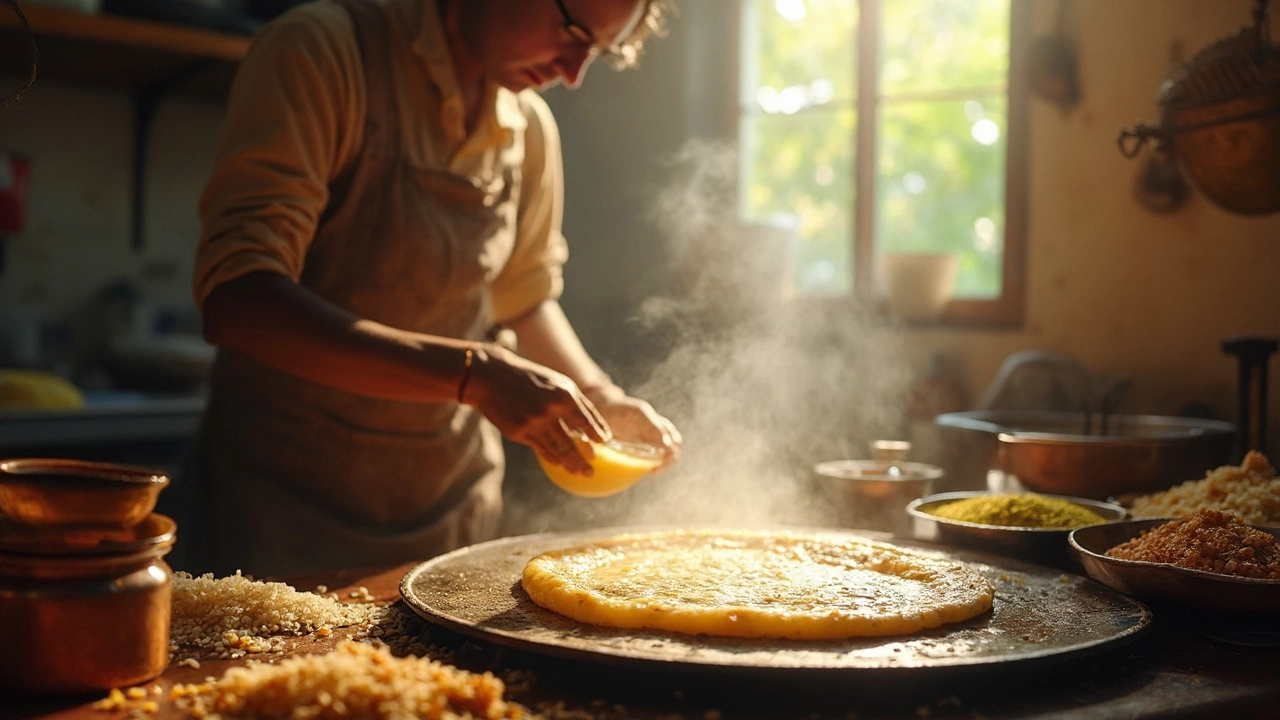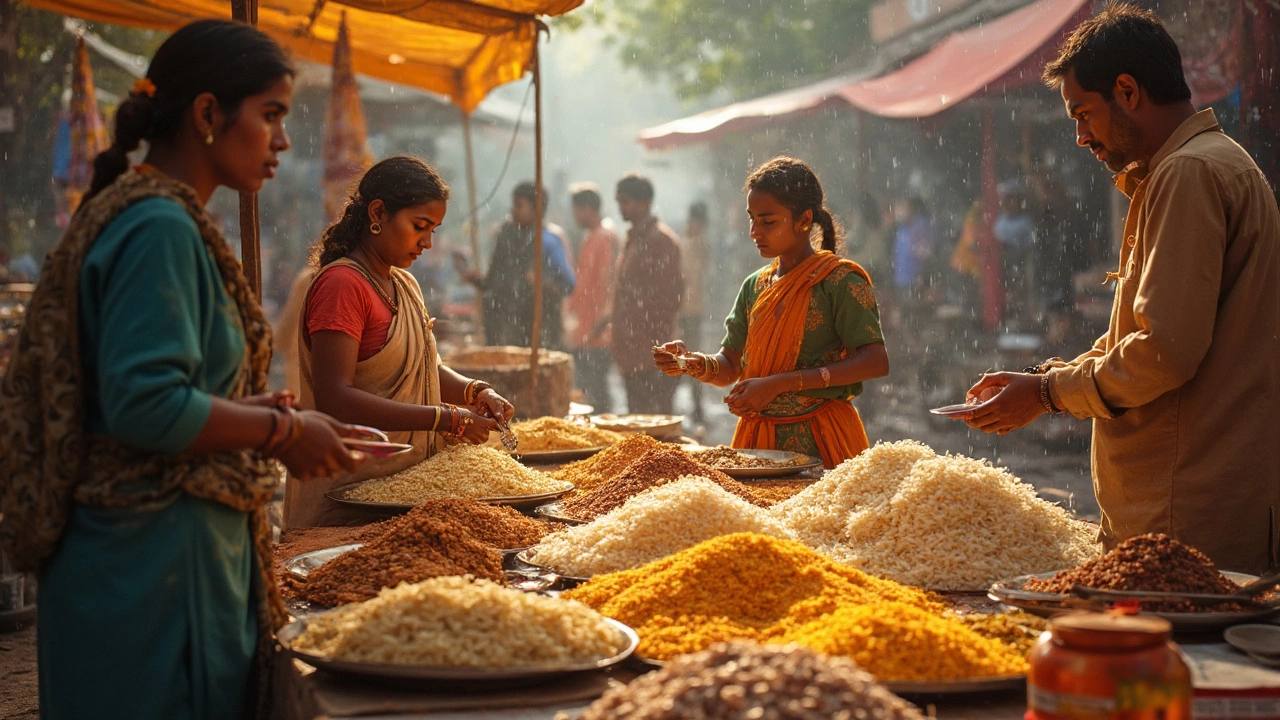Achieving Perfectly Fermented Dosa Batter Without Yeast
 Feb, 12 2025
Feb, 12 2025
Creating the perfect dosa batter without yeast might sound tricky, but it's totally doable! The key lies in understanding a bit of food science. Fermentation is all about creating the right environment for natural bacteria—especially lactic acid bacteria—to thrive. These little guys are everywhere, and with a bit of patience, they can transform simple ingredients like rice and lentils into a bubbling, tangy batter ready for your dosa pan.
The main players here are rice and urad dal (black gram). A standard proportion of 3:1 or 2:1, rice to dal, works wonders. The trick is to soak them separately before blending, as they have different textures and properties. Blend them smoothly with just enough water to make a thick, pourable paste.
Once your batter is ready, it's all about warmth and time. Like all good things, dosa batter flourishes when warm. In cooler climates, consider setting your batter near a light bulb or in a barely warmed oven to help things along. It'll usually take around 8 to 12 hours to ferment properly, but it can vary.
- Understanding Fermentation
- Key Ingredients
- The Fermentation Process
- Troubleshooting Tips
- Maximizing Fermentation Success
Understanding Fermentation
Fermentation is this amazing natural process that’s responsible for turning a plain mix of ingredients into a flavorful, airy dosa batter. It’s kind of like magic, but there’s real science behind it. Basically, fermentation is all about the growth and activity of wild bacteria and yeast, even though we're doing it without adding commercial yeast. These microorganisms feed on sugars in the batter, releasing gases like carbon dioxide, which puff up the batter and give it that lovely, light texture.
How It Works
Let's break down what actually happens. When you soak rice and urad dal, you're making it easier for the bacteria to access the starches. Once the batter is mixed, it’s a feast for these little microbes. They munch on the sugars and produce lactic acid, which improves the batter’s flavor and digestibility. That tangy taste? You can thank lactic acid for that!
Factors Affecting Fermentation
Fermentation isn’t a one-size-fits-all process; it depends on a lot of things. Temperature is key. Warm conditions help speed it up, which is why kitchens in warmer climates are perfect. Humidity also plays a role, as the moisture in the air can help sustain the activity of the bacteria. If you're in a cooler area, just keep the batter in a warm, cozy spot to get things going.
- Temperature: Ideal range is around 25-30°C (77-86°F).
- Time: Typically takes 8 to 12 hours.
- Ingredients: Quality matters, so use fresh rice and dal.
Natural Benefits
Fermented foods are pretty well-known for their health benefits, and dosa batter is no exception. It's easier to digest because the microorganisms in the batter improve its nutritional profile. So, when you’re making dosas the old-school way, you’re not just getting a delightful meal—you’re getting a health boost too!
Key Ingredients
To get that dosa batter just right, starting with the right ingredients is crucial. At its core, dosa batter requires just two main ingredients: rice and urad dal, also known as split black gram. Let's break down their roles.
Rice
The type of rice you choose matters. Most folks prefer using parboiled rice because it helps in achieving the perfect crispy texture for the dosa. Turmeric rice or any other short-grain rice can work too.
Urad Dal
This tiny but mighty ingredient is responsible for the batter's smoothness and fluffiness. It's packed with proteins and helps the fermentation process by providing essential nutrients for bacterial growth. A little goes a long way—typically 1 part urad dal to 2-3 parts rice.
Fenugreek Seeds
While optional, adding a small teaspoon of fenugreek seeds can enhance the fermentation process. These seeds aid in the yeast development, giving your batter an even better lift.
Water & Salt
Apart from soaking, you need water to grind the ingredients to a batter-like consistency. Adding salt post-fermentation ensures that the batter retains its activity and doesn't spoil too quickly.
Here's a table that summarizes the typical quantities you might use based on serving size:
| Ingredient | Quantity for 4 Servings |
|---|---|
| Rice | 3 cups |
| Urad Dal | 1 cup |
| Fenugreek Seeds | 1 tsp |
| Water | As needed |
| Salt | To taste |
Getting familiar with these core components is your first step on the path to no yeast fermented nirvana. So when you're ready to try it out, keep these simple ingredients in mind and let nature work its magic.

The Fermentation Process
Alright, let's get down to the nitty-gritty of making that dosa batter come alive without any yeast. The real magic happens when the wet batter sits, and this is what we call fermentation. By letting it rest, we give any naturally present bacteria the time and warmth they need to work their wonders. This leads to the batter rising, developing a slight tanginess, and becoming bubbly!
Setting the Right Environment
The best place for your batter to ferment is somewhere warm. Ideally, you want a spot around 86°F (30°C). In case your kitchen is cold, try keeping the container in an oven with the light on or near a heating element. If it's too warm, though, you could end up with batter that's more sour than you bargained for. Keep an eye on your climate.
Time is of the Essence
After blending your dosa batter ingredients, pour it into a large bowl, cover it loosely, and let it sit. Generally, a good fermentation will take about 8 to 12 hours. You’ll know it's ready when it’s puffed up to nearly double its size and has a soft, pleasant sour smell. Don’t be discouraged if it takes longer or happens quicker; things like humidity and ingredient freshness can influence the timing.
Practical Tips to Ensure Success
- Use a stainless steel or glass container to avoid any reaction with the batter during the fermentation stage.
- Consider adding a pinch of fenugreek seeds to the soak; they can speed up fermentation and enhance the flavor.
- If you're fermenting during winter, using a blanket or placing the bowl inside a warm, switched-off microwave can trap enough heat.
Once the batter is fermented, stir it gently before using it. Remember, this is the heart of making those perfect, crisp, and golden-brown dosas. Taking the time to get this right is half the battle won!
Troubleshooting Tips
So, your dosa batter isn't cooperating? No worries, it happens to the best of us! Let's look at some common hiccups and how to fix them.
Problem 1: My Batter Didn't Rise
If your batter isn't rising, it's probably due to low temperatures or insufficient fermentation time. To fix this, try placing the batter in a warmer spot. Remember that optimal room temperature is around 25°C to 30°C (77°F to 86°F). You might also want to let it ferment a bit longer.
- Check your water quality - chlorinated water can slow down fermentation.
- Use filtered water for soaking and grinding.
Problem 2: Batter Smells Bad
An off smell can indicate over-fermentation or contamination. Ensure all utensils used are clean and dry. If it's too sour, try storing the batter in the fridge immediately after fermentation to slow down the process.
- Discard a portion of the over-fermented batter and adjust with freshly made batter.
Problem 3: Dosas Stick to the Pan
A sticking dosa is a common issue but can be avoided by ensuring your pan is properly seasoned. Avoid using non-stick pans for traditional dosas, as they can interfere with batter setting.
- Keep the pan hot but not too hot - a sprinkle of water should sizzle and evaporate immediately to test.
- Use a sliced onion dipped in oil to smear the pan before each dosa.
Experiment and Adjust
Remember, dosa batter and fermentation have an element of art. Every kitchen is different, so experimentation is key. Try different fermenting times, monitor climate changes, and adjust your recipe accordingly.

Maximizing Fermentation Success
So, you're on a mission to nail that perfect dosa batter without yeast. Here's how you can push your fermentation game to the next level.
Choosing the Right Ingredients
Sounds basic, right? But seriously, the quality of your rice and urad dal matters. Look for aged rice and whole, split urad dal instead of the processed ones. They have a better starch content which helps the fermentation.
Water Matters
Ever thought about how water could affect fermentation? It's true. Use filtered water if you can; chlorine in tap water might tamper with the good bacteria you're trying to grow. Aim for a thick but pourable consistency to kick things off.
Temperature Control
Temperature is a biggie. Warm places work, but make sure it’s not too hot. You could try setting your batter in a slightly warmed oven or even wrap it up in a thick blanket. Around 25-30°C (77-86°F) is the sweet spot for those natural bacteria to do their thing.
Time and Patience
Patience is the name of the game. Depending on your climate, it may take anywhere from 8 to 14 hours. You’re looking for a batter that’s doubled in size and has a bubbly surface.
Troubleshooting Common Issues
- Batter's Not Rising?: Try a warm water bath by placing the container in a larger bowl with warm water.
- Too Sour?: Next time, reduce fermentation time, or add a pinch of sugar to balance it out.
- Too Thick or Thin?: Add water to thin it or some rice flour to thicken it up gently.
Remember, practice makes perfect, and with these tips, you'll be serving up those delicious dosas in no time!